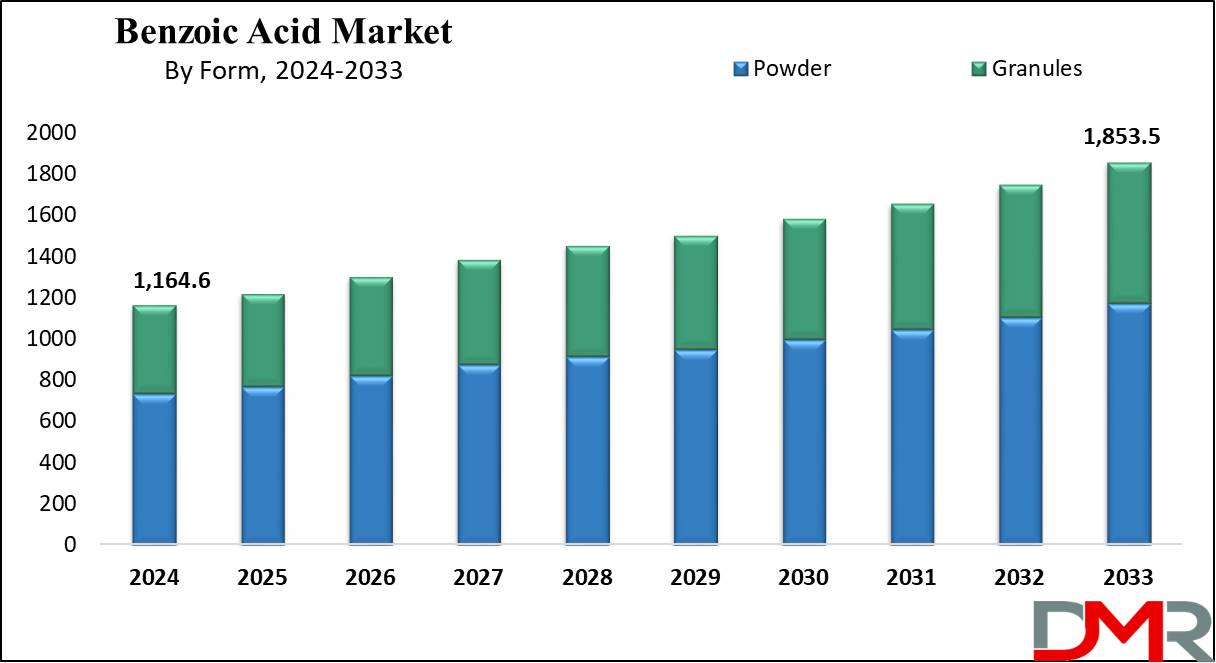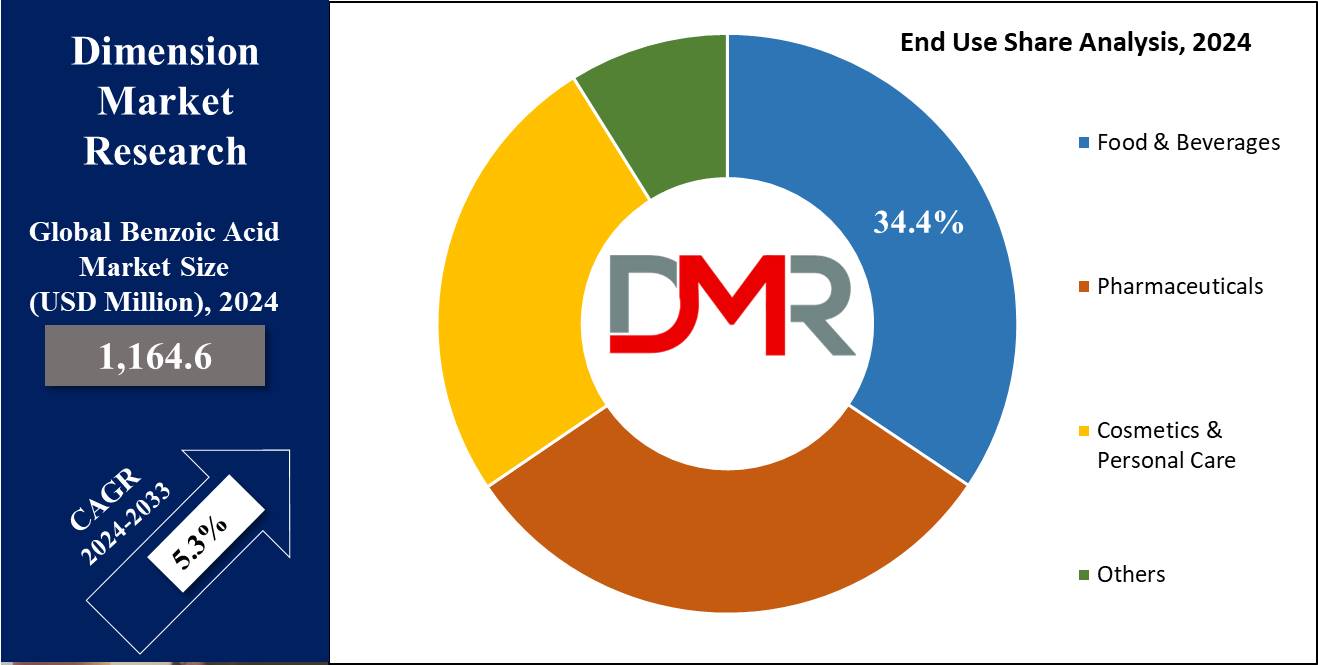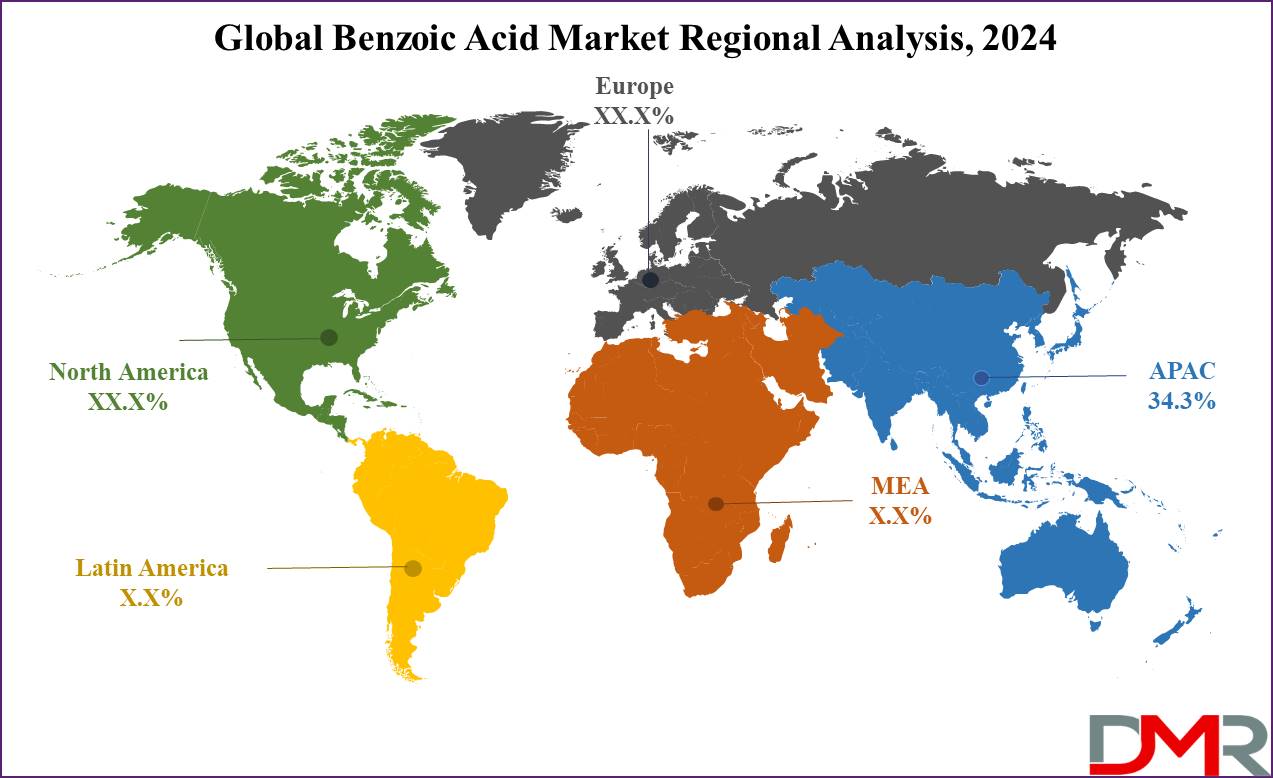Benzoic acid is a colorless and crystalline organic compound belonging to the carboxylic acid family which is manufactured in labs by oxidizing toluene at high temperatures with the help of manganese & cobalt salts as catalysts. This compound is soluble in several substances, such as alcohols, benzene, carbon tetrachloride, acetone, & water as they contain advantageous antibacterial & anti-fungal characteristics.

Benzoic acid finds applications in numerous sectors, due to its versatile characteristics, such as pharmaceuticals, chemicals, cosmetics, & the meat and dairy sectors. A significant application of this acid is its use as a preservative in various packaged, ready-to-eat, & canned food products, like fruit juices, jams, aerated drinks, pickles, & sparkling beverages as it preserves food without altering their taste & aroma. As the demand for these food products goes up globally, this market is anticipated to grow substantially. Furthermore, benzoic acid is easily available & also economical, which makes it a preferred choice over other alternatives for consumers. This easy availability & affordability have led to a surge in its usage across various industries.
Key Takeaways
- Market size: The Global Benzoic Acid market is projected to grow by 633.6 million, at a CAGR of 5.3 % from 2025 to 2033.
- Market Definition: Benzoic acid is a colorless, crystalline compound that is part of the carboxylic acid family which is produced by oxidizing toluene at high temperatures.
- Form Analysis: The benzoic acid market is segmented into powder and granules based on form. Powder form is projected to be the dominant force in the market capturing the largest revenue share in 2024.
- Application Analysis: The benzoate sector is anticipated to lead the market with a maximum share revenue in 2024 under the application segment.
- End-Use Analysis: The food & segment is expected to hold the largest market share of 34.4% in 2024 revenue under the end-use segment.
- Regional Analysis: Asia-Pacific is anticipated to dominate the benzoic acid market, capturing a revenue share of 34.3 % in 2024.
Use Cases
- Pharmaceutical Applications: Benzoic acid is commonly used as an antimicrobial agent in ointments, creams, and other topical medications, preventing bacterial and fungal infections.
- Preservatives in Food and Beverages: Sodium salt of benzoic acid is widely used as a preservative in the food and beverage industry due to its antimicrobial properties. They are known to increase the shelf life of acidic foods by obstructing the growth of mold, yeast, & some bacteria.
- Agricultural Uses: benzoic acid usage includes preserving animal feed and silage, and preventing spoilage by inhibiting the growth of mold and bacteria. They maintain the nutritional quality of the feed & reduce wastage.
- Industrial Applications: The benzoic acid market is primarily used to produce benzoyl chloride, which is essential in the manufacture of dyes, luxury perfumes, and other organic compounds. It is usually employed in the synthesis of alkyd resins, which are used in paints 7 coatings to improve their gloss, hardness, and chemical resistance.
Market Dynamic
Driver
Use in the medical field
Benzoic acid is used in the production of ointments which are antifungal, & are applied to treat many skin conditions like fungal infections, insect bites, ringworms, & burns. The demand for benzoic acid also increases as the desire for antifungal ointments increases due to the rise in cases of fungal infection. Additionally, this market experiences a surge from the growing demand in the production of artificial flavors & fragrances.
Application in Food items
Their acid salts are known for their strong antimicrobial properties; thus, it is used as preservatives in the food industry. It improves the pH level to prolong the shelf life of acidic food. It can be directly mixed with food items like canned goods, processed meats, fish, eggs, beverages (including soft drinks and juices), packaged snacks, baked goods, and vegetable products, driving the market growth.
Restraints
Health risks associated with Benzoic acid
Higher intake of beverages having sodium benzoate or benzoic acid badly affects health, such as increased ADHD symptoms in adults. Moreover, the salt form of benzoic acid, sodium benzoate, has been associated with hyperactivity. Furthermore, when benzoic acid is combined with vitamin C, it can form benzene. Beverages often contain carbonated components & when combined with benzoic acid, may contain more amounts of benzene, which has been linked to an increased chance of cancer.
Opportunities
Mental Health Benefits of Benzoic Acid
These acids are valuable in many industries including food and beverages, cosmetics, and pharmaceuticals. According to recent studies, benzoic acid is also beneficial for mental health. A salt derivative of benzoic acid, benzoate, helps to reduce major depression and panic disorders. Thus, it shows significant growth opportunities for these acids in the pharmaceutical sector for medicinal applications.
Trend
Demand in the packaged food, beverage, and pharma industry
Benzoic acid is as a preservative to increase the shelf life of food products. The rising popularity of processed foods, soft drinks, and packaged foods, increases the demand of this market. Their ability to repel mold and yeast makes them useful as a preservative in many applications. The growing consumer preference for convenient, ready-to-eat meals and the increasing urbanization are driving the demand of this market.
Research Scope and Analysis
By Form
Among the several forms of benzoic acid, the segment of powder stands is predicted to dominate with the maximum share in 2024. The powder form of benzoic acid is marked by its easy solubility, white amorphous appearance, & better impact on acidic pH levels. It finds extensive usage as a food preservative in products such as pickles, soft drinks, fruit juices, & vegetable salads. By avoiding the formation of fungus & bacteria in these food items, benzoic acid powder extends shelf life, making it more valuable for preserving food products that need to be stored for longer duration.
However, the granules form of benzoic acid is anticipated to experience significant growth in the upcoming years. Granules are essentially the salt of benzoic acid, & they show rapid dissolvability in water. This property makes them useful for enhancing the shelf life of products & protecting against the growth of harmful bacteria and fungi. Hence, the demand for granules form of benzoic acid is anticipated to increase, as it proves to be an effective preservative in several sectors, particularly in the food sector where preserving product freshness & safety is important.
By Application
Under the segment of the application, the Benzoate category is predicted to dominate the Benzoic market, with a maximum share in 2024. Within the category of benzoate, there are two main forms: mono-benzoates & di-benzoates, both of which are obtained from benzoic acid. These compounds find extensive usage in several items such as wall coverings, floor coverings, inks and waxes, adhesives and sealants, films, & board products. The rising desire for phthalate-free plasticizers has resulted in a rise in the utilization of benzoic acid. As non-phthalate plasticizers are preferred over phthalate plasticizers, the market for benzoic acid is expanding.
One of the significant driving forces for the benzoate market is its rising demand from the food industry. It serves as an effective preservative, especially at pH levels below 4.5, and its preservative properties become more efficient at lower pH levels. Another reason for the growth of the sodium benzoate market globally is the increased usage of synthetic preservatives for poultry in India and China region.
By End-Use
The food & beverages sector is anticipated to lead the benzoic acid market with a maximum share of 34.4% in 2024 under the end-use segment. This increase in growth is majorly propelled by its extensive usage as a preservative in most packaged foods & beverages. It is mainly effective in preserving products that include acids, such as jams, pickles, carbonated beverages, fruit juices, & sparkling drinks. The benefits of using benzoic acid as a food preservative lie in its ability to maintain the natural flavor & aroma of the food or drink, making it the most preferred choice in the sector.

The increasing demand for benzoic acid as a food preservative is further risen by shifting customers' choices towards packaged foods & beverages and the growing per capita income among people. Moreover, the rising desire for frozen food & beverages has risen, leading to significant growth in the packaged food & beverages sector.
The Global Benzoic Acid Market Report is segmented based on the following
By Form
By Application
- Benzoates
- Sodium Benzoate
- Potassium Benzoate
- Benzyl Benzoate
- Benzoates Plasticizers
- Alkyd Resins
- Benzoyl Chloride
- Animal Feed Additives
By End-Use
- Pharmaceuticals
- Foods & Beverages
- Bakery & Confectionery
- Beverages
- Meat Products
- Sauces/ Dips/ Salad Dressings
- Dairy products
- Others
- Cosmetics & Personal care
- Others
Regional Analysis
The Asia-Pacific region is anticipated to emerge as the dominant market for benzoic acid
with a 34.3% share by the end of 2024. Several factors contributed to the market's growth in this region, such as the rising desire for frozen food, changing customer choices, & increasing per capita incomes. The existence of a large young population in the Asia-Pacific region, together with hectic lifestyles, has led to a significant shift towards processed & packaged items, escalating the demand for benzoic acid in the region. One of the major drivers of the benzoic acid market in the Asia-Pacific is the adoption of stringent government policies, due to which benzoate plasticizers are been used instead of phthalate plasticizers. Furthermore, the sector of animal feed is gaining popularity in nations such as India, which has further led to a rise in the demand for benzoic acid in the market.

North America is another rapidly growing market for benzoic acid. The region's market growth is majorly accredited to the robust expansion of the food & beverages sector. Moreover, Canada & the U.S. are anticipated to be significant contributors to the growth of this market. Additionally, the growing desire for cosmetic products in the region also fosters the demand for benzoic acid.
By Region
North America
Europe
- Germany
- The U.K.
- France
- Italy
- Russia
- Spain
- Benelux
- Nordic
- Rest of Europe
Asia-Pacific
- China
- Japan
- South Korea
- India
- ANZ
- ASEAN
- Rest of Asia-Pacific
Latin America
- Brazil
- Mexico
- Argentina
- Colombia
- Rest of Latin America
Middle East & Africa
- Saudi Arabia
- UAE
- South Africa
- Israel
- Egypt
- Rest of MEA
Competitive Landscape
Major market players in the benzoic acid market are implementing various strategic initiatives, including product launches, mergers, joint ventures, acquisitions, and geographical expansion. These strategic moves by major players in the benzoic acid market reflect their proactive approach to capturing opportunities and expanding their operations. By engaging in such partnerships, acquisitions, and geographical expansions, these companies aim to strengthen their positions and tap into new markets, ultimately driving growth and competitiveness in the benzoic acid industry.
Some of the prominent players in the Global Benzoic Acid Market are
- THE CHEMICAL COMPANY
- I G Petrochemicals Limited
- Merck KGaA
- Chemcrux Enterprises Ltd.
- GFS Chemicals Inc.
- Hemadri Chemicals
- Eastman Chemical Company
- Ganesh Benzoplast Limited
- Spectrum Chemical
- Other Key Players
Recent Development
- In July 2025, global demand for benzoic acid surged, pushing record price hikes and encouraging manufacturers to scale up capacity for new product variants.
- In June 2025, the benzoic acid market experienced significant upward momentum, with producers launching improved grades focused on food and pharma applications, driven by changing safety regulations.
- In May 2025, Selenis manufactured recycled PET chips using terephthalic acid from Circ®, moving towards an offtake partnership to commercialize sustainable benzoic acid applications in textiles.
- In December 2024, global benzoic acid producers announced R&D investments into ultra-fine powders for food and drug formulations, citing strong funding growth in Asia and Europe.
- In 2024, increased merger activity and manufacturing alliances were reported, with several global players executing expansion strategies and collaborations within the specialty chemicals sector.